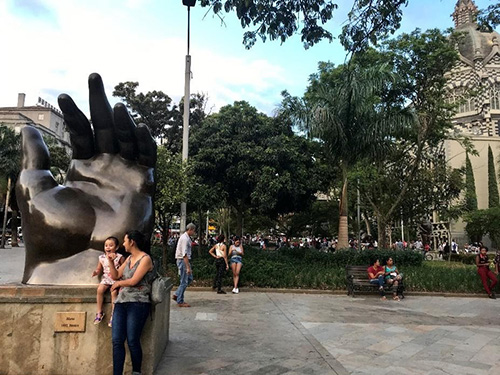言語選択
News
Julio en Medellin - July 2019 in Medellin (By Tricia Okada)
May 19, 2020 : Essays
One of the perks of being in the academe is having the chance to participate in conferences or workshops, presenting your research, receiving feedback, meeting and exchanging ideas with other scholars. This year, I was privileged to present with my colleagues our research on communication strategies at the English as a Lingua Franca 12 (ELF 12) in Medellin, Columbia. Although traveling to the other side of the globe requires long flights with a transit and time difference accompanied with jetlag, attending the conference in Medellin was still worth it.
Distance can be one of the reasons why this year’s conference was limited in attendance than the previous years. Nonetheless, video teleconference made it possible to have plenary speakers from Europe engage in discussions with the participants while other presentations, including ours, went smoothly. Thanks to the conference organizers supported by efficient graduate students of the Universidad de Antioquia (University of Antioquia) for a successful conference. All the English-speaking student volunteers majoring in foreign languages can speak at least three languages and were pleased to be a part of the conference as this experience was quite rare for them. In addition, what a warm welcome speech by the department head when she said, “we are grateful to have you (participants from various countries) here to witness the transformation of Medellin.”
I was communicating in English at the University of Antioquia and the hotel but I was surprised to catch myself picking up Spanish words and communicating in my broken Spanish. My home country, the Philippines was colonized by Spain for more than three centuries so the Spanish language has a major influence in Filipino language or Tagalog. During my brief stay, the following Spanish loanwords in Filipino became useful---kumusta (how is/are), libre (free), direcho (straight), byahe (visit), maleta (luggage), banyo (restroom), kotse (car), kwarto (room), kwatro (four), litrato (photograph), baso (glass), kutsara (spoon), Hapones (Japan), Biyernes (Friday), and so on. This experience made me more interested to learn Spanish. At times when I found myself having trouble communicating at a supermarket, post office, and train station, locals who can speak English would turn up to help me.
What strikes me is how Medellin reminds me of home. Medellin, the second-largest city in Columbia is called the “City of Eternal Spring” as it is warm during the day and cool at night. I expected to eat tropical fruits and was glad to find out that they have soursop (guyabano in Filipino and guanabana in Spanish). Similar to Filipino food, Colombian food involves a lot of protein and carbohydrates like empanada, arroz attolado (rice with pork). Colombia is known for good coffee but the best brand recommended by locals is Juan Valdez. The Colombians, who usually enjoy drinking hot coffee, exude warm hospitality and a positive vibe that reminds me of Filipinos. In public places, I saw strangers usually exchange smiles and small talk, and even stray dogs are calm and friendly. The chill atmosphere, the tasty food, and most especially, the cheerful people made me feel like a weekday is a weekend.

Photo details: Plaza Botero on a Thursday late afternoon in July, 2019
